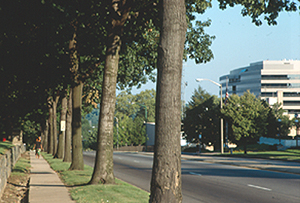Home > Site analysis > Choosing desirable tree attributes > Form
Form
Match form to function
Tree form varies from tall and thin (Lombardy poplar or Italian cypress) to short and wide (live oak, bur oak). After considering the physical attributes and limitations at the planting site, the most appropriate form for a particular planting site depends on the function that tree will provide. For example, you would not plant a Lombardy poplar or Italian cypress for a shade tree or for erosion control. A live oak or sugar maple is more appropriate.
A pyramidal tree with drooping branches such as pin oak may not be a good choice for planting near a street intersection because low branches would block visibility. One with an upright or vase shape such as zelkova would be more appropriate.
Form affects maintenance requirements
Selecting the proper tree form can have a big impact on tree maintenance requirements after planting. For example, there are many urban landscape situations that call for trees near pavement. Small, spreading trees such as multi-trunked versions of amur maple, crabapples, kousa dogwood or Jerusalem thorn planted near a walk or pavement require regular pruning if planted too close, whereas, a small upright tree or a larger tree can be trained to grow over the walk or street (see drawing).
Trees with a pyramidal form usually require less pruning to develop strong branch structure than those with other forms. Trees with rounded, oval or spreading canopies often need periodic pruning in the first 20 years after planting to ensure good structure. Remember that many trees normally producing several trunks can be trained in the nursery to a more upright form. These can make nnice street trees. Look for these at your nursery.

See: drawing of desirable tree form along streets and sidewalks
Maintaining uniform canopies
 Many commercial landscape designs call for a number of uniform trees planted in rows, or in
other formal arrangements. Cultivated varieties (cultivars) of popular species
are often planted because cultivars have the potential to grow with a uniform
canopy habit.
Many commercial landscape designs call for a number of uniform trees planted in rows, or in
other formal arrangements. Cultivated varieties (cultivars) of popular species
are often planted because cultivars have the potential to grow with a uniform
canopy habit.
If soil conditions at the planting site are uniform, then canopies have a good chance of maintaining a fairly uniform habit and size in the landscape. However, more often than not, trees grow at different rates following planting because soil conditions vary. This might spoil an otherwise well planned landscape design because all trees will not have identical canopies.
A good method of maintaining uniform canopies in a landscape design is to create uniform soil conditions, then pick a species that will grow in that soil. Another (more expensive) method is to choose the species or cultivar first, then create the soil conditions that will support that tree.

